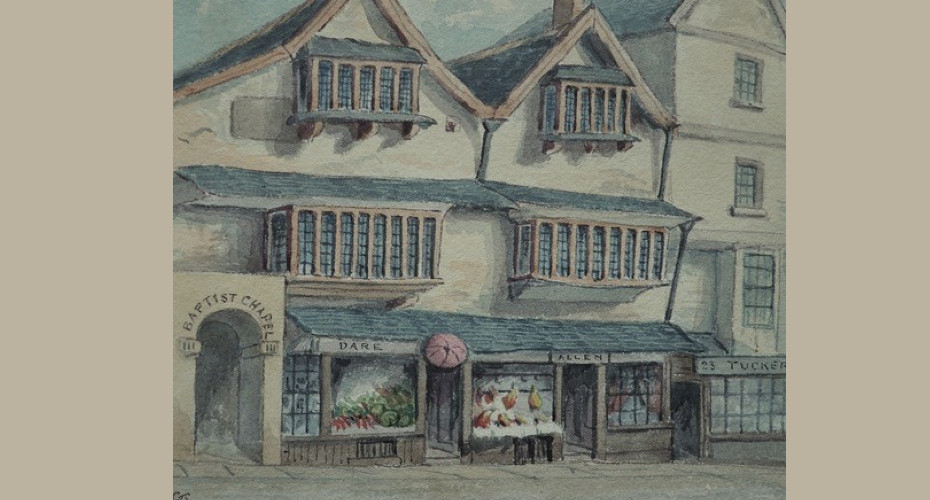Origins of ancient Elizabethan decorative treasure discovered hundreds of years after demolition

The pair of Elizabethan buildings containing the panelling stood in front of a Baptist Chapel in South Street, Exeter
The origins of a stunning ancient Elizabethan decorative treasure has been revealed – hundreds of years after the building which housed it was demolished.
Experts have long studied the oak panelling which is now held by the Victoria and Albert Museum in London, but its original home was a mystery.
Exeter historian Dr Todd Gray has discovered the panelling was created for a house in South Street, demolished in the Victoria era.
The story of the panelling is told in Dr Gray’s new book, Exeter’s Lost Buildings/ Destruction from 1800 to 1899, which tells the dramatic story of the city’s changing streets. Of the 1,500 or so buildings in the city centre that existed in 1800 only a small number survived fire, redevelopment and improvement and were still standing in 1900. Items from destroyed buildings such as windows, doors, fireplaces, panelling, roof tiles and statues can be found in the Royal Albert Memorial Museum and Art Gallery, Victoria & Albert Museum and the Metropolitan Museum in New York City.
The book outlines how during every year of the 1800s at least one building in Exeter was refurbished or rebuilt. The book, which features buildings within the city’s ancient walls, also shows how the downturn of Exeter’s economy in the early 1800s led to ancient buildings remaining.
The pair of Elizabethan buildings containing the panelling stood in front of a Baptist Chapel which opened in January 1725. It was replaced in 1823 when the front buildings housed a butchers and grocers. They were all demolished in the spring of 1855 after the city surveyor determined that they were unfit and the congregation concluded the rebuilding costs were prohibitive.
Materials from the building – including an “ancient oak carved work” with “wainscot of the napkin or drapery and the mask and lion’s head patterns” were auctioned. Some ‘fine old carved work’, part of the ‘many beautiful and elaborate specimens of the carved and wainscot panels diversified with acanthus, lion’s heads and arabesques’, was purchased by John Gendall for £12 12s, the equivalent of more than £1,000 in today’s terms.
The building also had ornate plasterwork, including a Royal Coat of Arms, which led to a misguided notion that the building was associated with a visit to Exeter by James I. Its current location is unknown. A fireplace had a tablet bearing the initials T. T. and S. T., possibly previous residents of the building, Thomas and Sarah Tooker, along with the date 1627.
The alleged Royal association helped build public interest in the auction: antiquarians visited who ‘took hasty sketches’ including George Townsend.
The book says John Gendall may have initially used the panelling at his home, 10 Cathedral Close, which retains two late-seventeenth-century panels.
The panelling was purchased for £50 in 1856 by the South Kensington Museum – known since 1900 as the Victoria and Albert Museum. Records describe it as “Elizabethan oak room panelling removed from a house near Exeter” and it remains in the museum’s collection.
Nick Humphrey, Victoria and Albert Museum Curator, Furniture and Woodwork 1300-1700, said: “At this early date in the museum’s collecting, it was a large and significant acquisition, its appeal based on the wide range of crisply carved renaissance style decorative motifs, and its good condition.
“Over the decades since, the panelling has been often studied and parts of it displayed within the Museum, notably in the 1970s to evoke a panelled room around the Great Bed of Ware, and more recently on loan to Exeter’s Royal Albert Memorial Museum and Art Gallery.
“But until now the building from which the panelling was removed has been a mystery. Todd Gray’s rediscovery of its location in South Street, along with tantalising clues as to the seventeenth-century residents of the house, is hugely significant. When so much early English woodwork of the early modern period lacks the key contextual information that would permit historians to understand it and bring it alive, Todd’s findings raise the exciting possibility of revealing much more specific information about the building, its use and owners, both at the time when the panelling was installed and subsequently until it was demolished.
“In retrieving and explaining the roles of John Gendall as its purchaser at auction in 1855, and George Townsend as an accurate witness and recorder of its appearance at the time, Todd has added further fascinating and important detail to the story of its remarkable survival.”
While researching the book Dr Gray has used the records of the two most energetic promoters of demolishing buildings, the Commissioners of Improvement and the Dean & Chapter, as well as those of the City Chamber, City Council and the Society for the Protection of Ancient Buildings. He also examined documents owned by the Ford family and Exeter Freemasons and papers at the Bodleian Library. Dr Gray has also examined documents in archives across the country and in the United States, as well as local newspapers and drawings made of the lost structures which disappeared generations ago.



